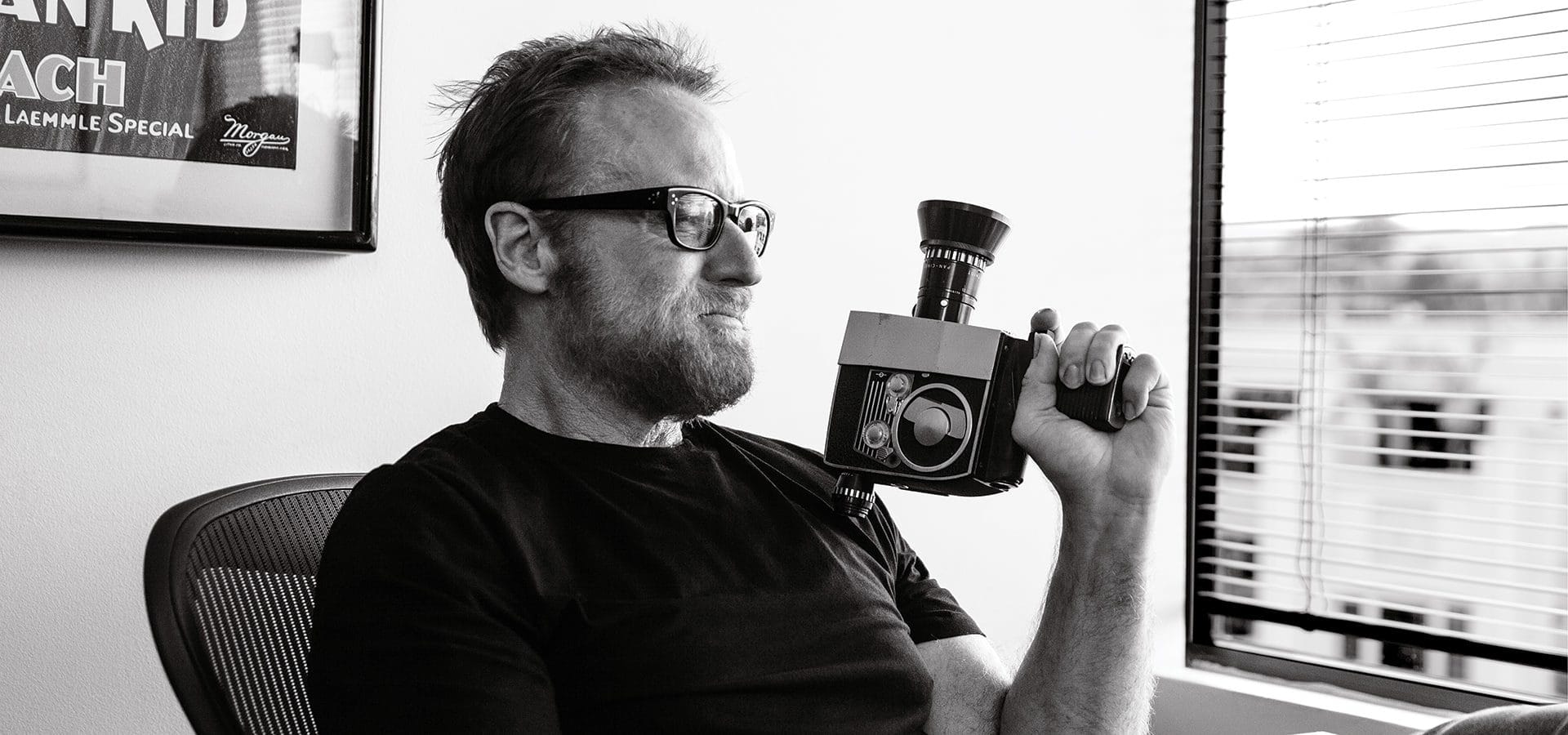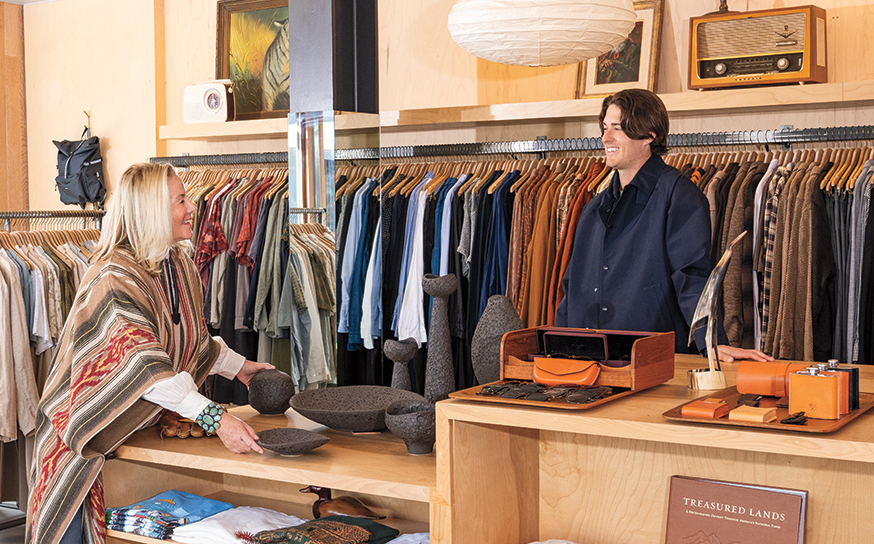Documentarian Peter Jones Pivots His Lens to Southern California’s Ambitious Aviation Age
Wheels up.
- CategoryPeople
- Written byRobert Earle Howells
- Photographed byPhillip Graybill
Very early in Blue Sky Metropolis, Peter Jones’ four-part documentary on the history of aviation in Southern California, we see an old film clip of a propeller-driven dirigible attempting to take off during the 1910 Los Angeles International Air Meet in Dominguez Hills. It looks utterly preposterous. No one watching—then or now—could hold any hope of it getting airborne. But fly it does, as a nattily attired and apparently untethered pilot steers from an exposed framework underneath the behemoth airship.
The image says a great deal. It speaks to the audacity of early aviation pioneers, those magnificent men and women in their flying machines. It speaks to the power of dreams and to the can-do spirit of a collection of dreamers. And more specifically, it establishes Los Angeles—and all of Southern California—as the cynosure of a nascent movement to reach the sky, the heavens and beyond. The dreams and the dreamers belonged uniquely to Southern California.
Incidentally, that 10-day air show—only the second in the world—drew 254,000 spectators at a time when the population of Los Angeles was 319,000.
“The ability to fly is the most coveted of superpowers—more than immortality, superhuman strength, speed or intelligence,” says Jones through Blue Sky narrator Tony Goldwyn, as we watch an aerobatic pilot loop-de-looping in the sky, inscribing fantastic cursive contrails in the plane’s wake. “For more than a century, Southern California has been a primary point of access to the heavens. First the skies, then space.”
Just about then, the visual shifts to telescope images of a dreamscape of nebula, stars and distant galaxies, and the point is driven home: Southern California is more than the historic setting for the development of aviation. It is also the present and the future of aerospace. It is the vantage from which we gaze into the heavens and continue to realize the dreams portrayed by those magnificent flying machines and their makers in 1910.
But Blue Sky Metropolis has even more to say than that. As we learn in the course of four hour-long episodes, the development of aviation didn’t just coincide with the development and growth of the Los Angeles metropolitan area. It essentially dictated it.
By 1929 there were 53 landing fields within 30 miles of Los Angeles City Hall. Most were developed by aircraft manufacturers. Those sites determined population patterns in places like Hawthorne, Burbank and Lakewood (touted as “Tomorrow’s City Today”), as workers settled in suburban clusters surrounding these scattered aviation hubs.
All the while, another force was at work, perfectly coinciding with the burgeoning growth of LA and aviation: the motion picture industry. As footage from that 1910 air show testifies, cameras were present from the moment of creation onward, and celebrity culture overlapped both arenas. It’s no coincidence that the first Academy Award for best picture went to the film Wings in 1929, and that Jones titled the first episode of his series “Wings.”
An intoxicating sense of showmanship permeated the early days of aviation, whose pioneers inevitably became celebrities. We see Amelia Earhart glammed up for publicity photos and endorsements. We see spectacular aerial footage from the 1930 film Hell’s Angels and learn that a certain aircraft manufacturer and film director named Howard Hughes flew many of the stunt scenes himself. Later we see Walt Disney devoting the resources of his film studio to aid the war effort in the early 1940s, using cinema-style magic to disguise aircraft plants as towns and cities.
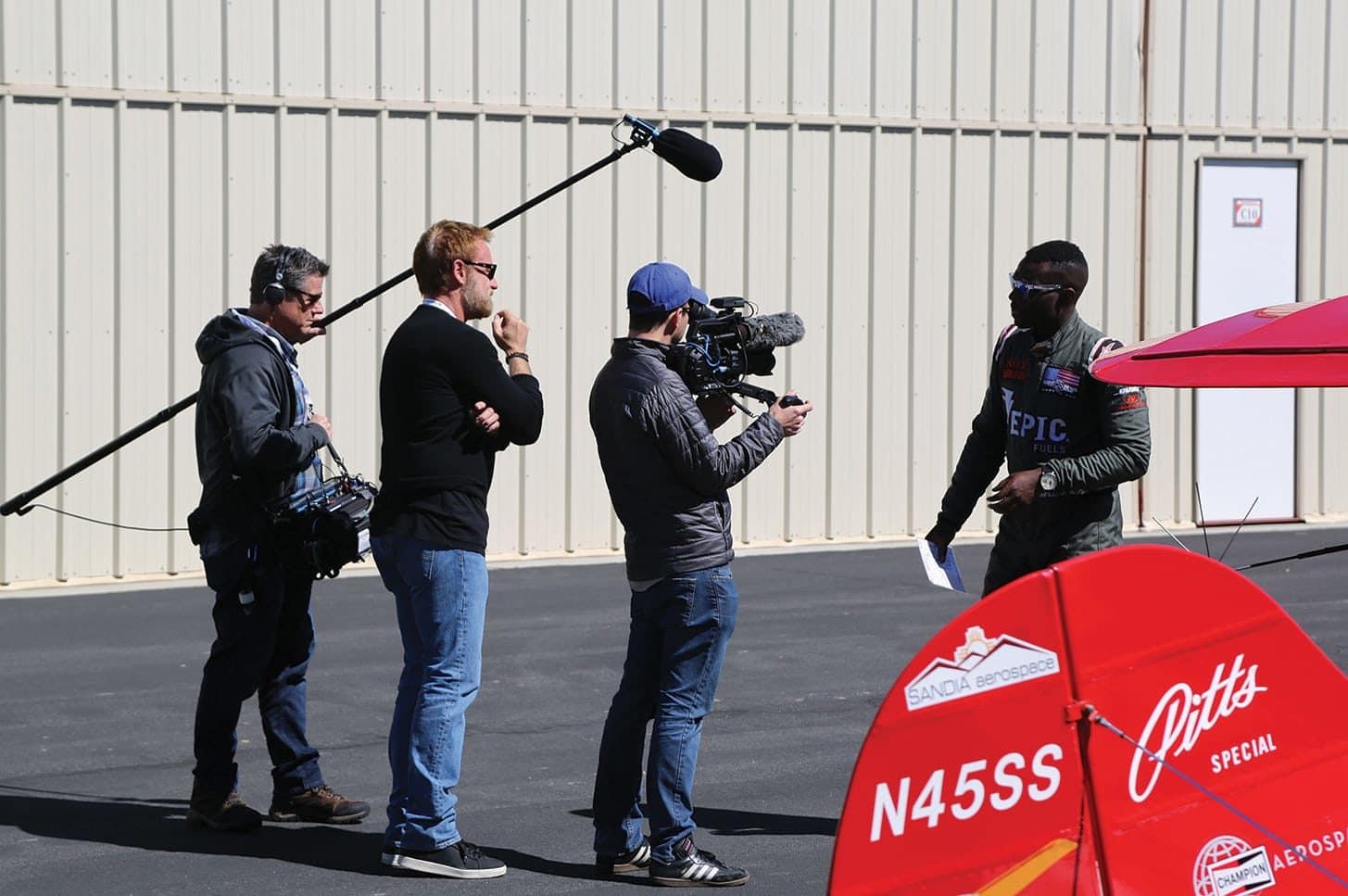
Interviewing stunt pilot Anthony Oshinuga, who is featured in Blue Sky Metropolis
Photo courtesy of Peter Jones
Born to Make This Movie
It’s not a stretch to assert that Peter Jones was born and bred to make Blue Sky Metropolis, which he wrote, directed and produced. Jones is a Los Angeles native and Stanford grad who studied the art of biography and 20th-century American history under Pulitzer Prize-winning historian David M. Kennedy and honed his journalistic chops as a television reporter in Virginia and Texas.
When he returned to Los Angeles, it was to make Hollywood celebrity documentaries that inevitably told the story of the place as well as the people. Two of his celebrity docs won prime-time Emmy awards: Judy Garland: Beyond the Rainbow (1997) and Stardust: The Bette Davis Story (2006).
His bio-documentary Johnny Carson: King of Late Night (2012) for PBS remains the highest-rated film in the network’s American Masters series. Jones dived even deeper into LA history with his two-hour documentary Inventing LA: The Chandlers and Their Times (2009) about the history of the Los Angeles Times and the dynasty of its longtime owners, the Chandler family. That film won a Peabody Award.
So when PBS SoCal’s Juan Devis reached out to Jones about making a documentary on the history of aerospace for KCET, it was with that background in mind: LA native, a crack track record of documentary filmmaking and a deep sense of LA history. He didn’t realize that Jones also had aviation and showbiz running through his veins.
“It was only later,” recalls Jones, “that Juan found out about my father. Having a name like Jones gives you great anonymity.”
Peter Jones’ father was Thomas V. Jones, the CEO of Northrop Corporation for 30 years and the man who guided the manufacture of the T-38, which became one of the world’s most successful fighter jets. He pioneered the making of drones (initially for the motion picture industry) and won the coveted contract to build the B-2 stealth bomber.
So aviation entered Jones’ consciousness somewhat by osmosis. “I would hear him [his father talking aviation] on the phone late at night, and there were parties at the house with generals, politicians and royalty. We got a pound of caviar every Christmas from the shah of Iran.” As a young boy, he went snorkeling with rocketry wizard Wernher von Braun and as a teen once sat beside aviation pioneer General Jimmy Doolittle at dinner.
“My father was one of the first executives to have a Gulfstream—his pilot flew Air Force One for LBJ—so flying around in that was fun. But I was a kid. That was my world. I only learned how different it was as I lived the rest of my life.”
Did he ever have a desire to pilot airplanes? “Absolutely not. I was right brain.” But like most kids of his generation, Jones followed the space program. “I loved watching the launches, loved astronauts.” Hanging on a wall in his Brentwood office are autographs of Neil Armstrong, Wally Schirra and Alan Shepherd—obtained by dint of his paternal connections.
All the while, showbiz hovered in the Jones household. His grandfather was actor Conrad Nagel, who was among the founders of the Academy of Motion Picture Arts and Sciences. His step-grandfather was Sidney Franklin, who directed the film The Good Earth and produced Mrs. Miniver and Random Harvest.
“I grew up around creators of fiction, but I wanted to tell stories about real people,” Jones recalls. He cites the freshman-year seminar he took at Stanford with David M. Kennedy as particularly influential. “It was called Biography/Autobiography/History. I learned that you can absorb the history of an era through the life of an individual who experienced it. Through someone’s life, you can offer a view of life and understand the human condition. How did Judy Garland or Otis Chandler respond to life? What does that say about the human experience?”
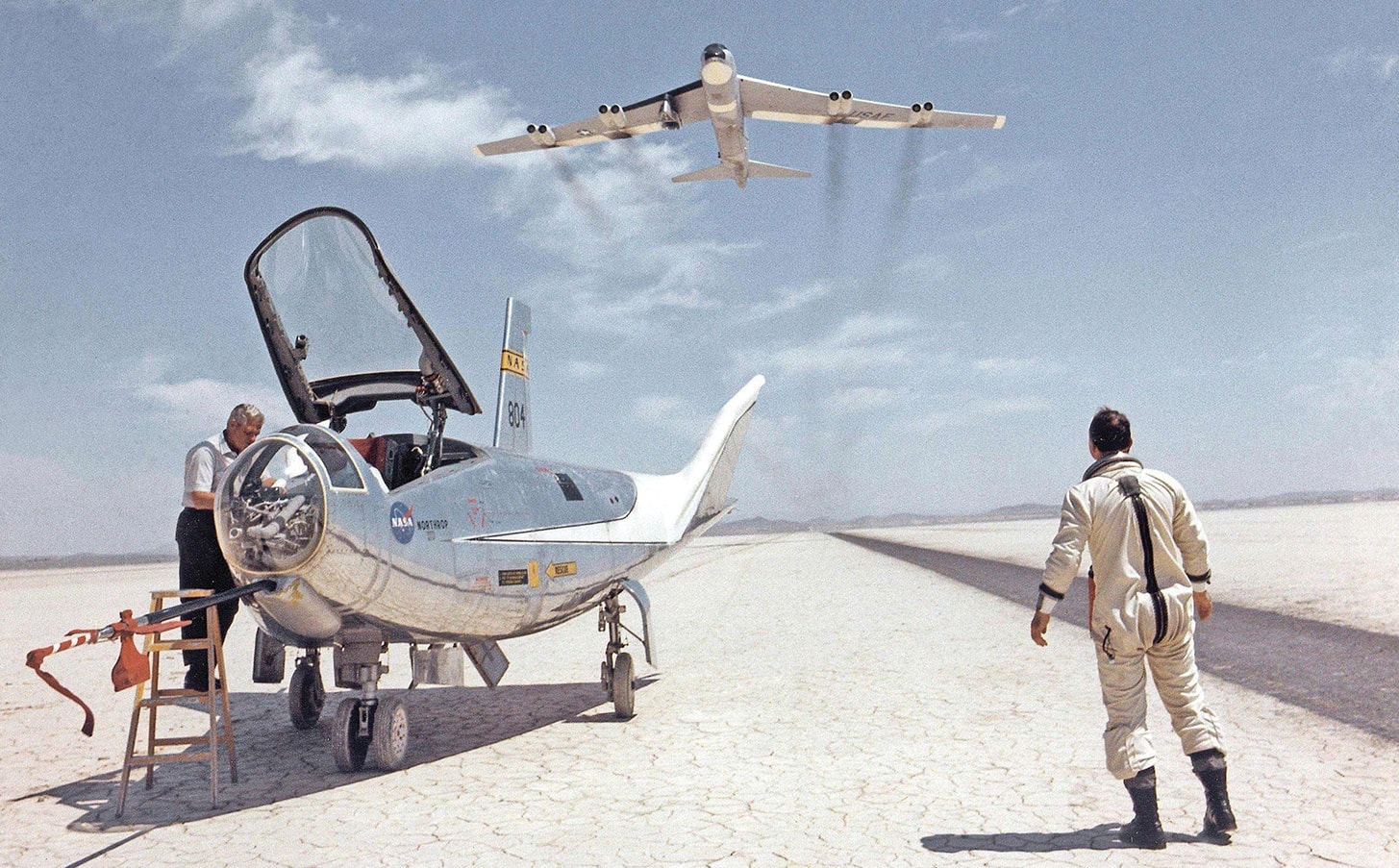
A B-52 soars above a Northrup HL-10 and pilot Bruce Peterson after a test flight at Edwards Air Force Base, circa 1966.
Photo courtesy of NASA
(SERIES SIGNATURE IMAGE)
Aviation as a Human Experience
It’s not surprising, then, that much of the storytelling in Blue Sky Metropolis focuses on individuals—and many of them you likely have not heard of. Among his favorite on-camera interviewees, who include a slew of academics, historians and engineers, was a former truck driver from Downey: Bob Thompson, who drove for North American Rockwell.
“Through the beginning of time, all the great leaders of the world have seen the moon,” Thompson tells Jones. “Even Jesus Christ himself has seen that moon. And Downey was the place that built that vehicle that took that man to the moon for the first time, and I’m very proud of that.”
Jones introduces us to a Jet Propulsion Laboratory (JPL) engineer named Sue Finley and returns to her several times. Finley began working for NASA in 1958 and was tasked with solving complex math equations using pencils, paper and gigantic first-generation Friden calculators.
“She was a human computer,” says Jones. “She calculated rocket launch trajectories by hand. I loved having a real human being speaking for generations of women who were supposed to be stay-at-home moms. It was OK to have a career and to be a professional.”
We see early shots of Finley as a fresh-faced working gal, in the parlance of the time, and a shot of her colleagues in a room filled with women at their desks—reminiscent of familiar images of clerical pools. But these women were not secretaries. They were rocket scientists.
Finley still is one, though at one point she retired for six years to raise a family. She returned to JPL, where she remains an engineer for the NASA Deep Space Network that she helped create. “Sue was a perfect example of telling history through an individual,” adds Jones.
“I grew up around creators of fiction, but I wanted to tell stories about real people.”
Featured prominently in Episode 4 are two other aerospace women whose stories underscore the critical role immigrants have played in aviation—and Southern California—history. Diana Trujillo tells how she spoke no English when she came to the U.S. at age 17—fleeing drug violence in Colombia—then worked her way through college as a housekeeper to eventually became one of the chief engineers on Curiosity, NASA’s vaunted Mars rover.
Her colleague Vandi Verma recounts her journey from India to JPL, where she specializes in the robotic technology that controls the Mars rover. The women are currently working together on Mars 2020, a rover due to launch sometime this year.
Jones weaves other social-trend stories into Blue Sky Metropolis—never from a soapbox vantage but rather by depicting human experiences of the time. He tells in Episode 1 how a shortage of white male labor in the aircraft industry prompted the hiring of, first, light-skinned Hispanics, then women, then high school students—and yet North American wouldn’t hire African Americans except as janitors.
Even President Franklin Roosevelt’s Executive Order 8002 in 1941, banning discriminatory employment practices in the nation’s defense industry, is depicted largely as an act of necessity rather than justice. “Sometimes change occurs this way,” says Jones. “It was: ‘We need these airplanes, so you’ve got a job.’”
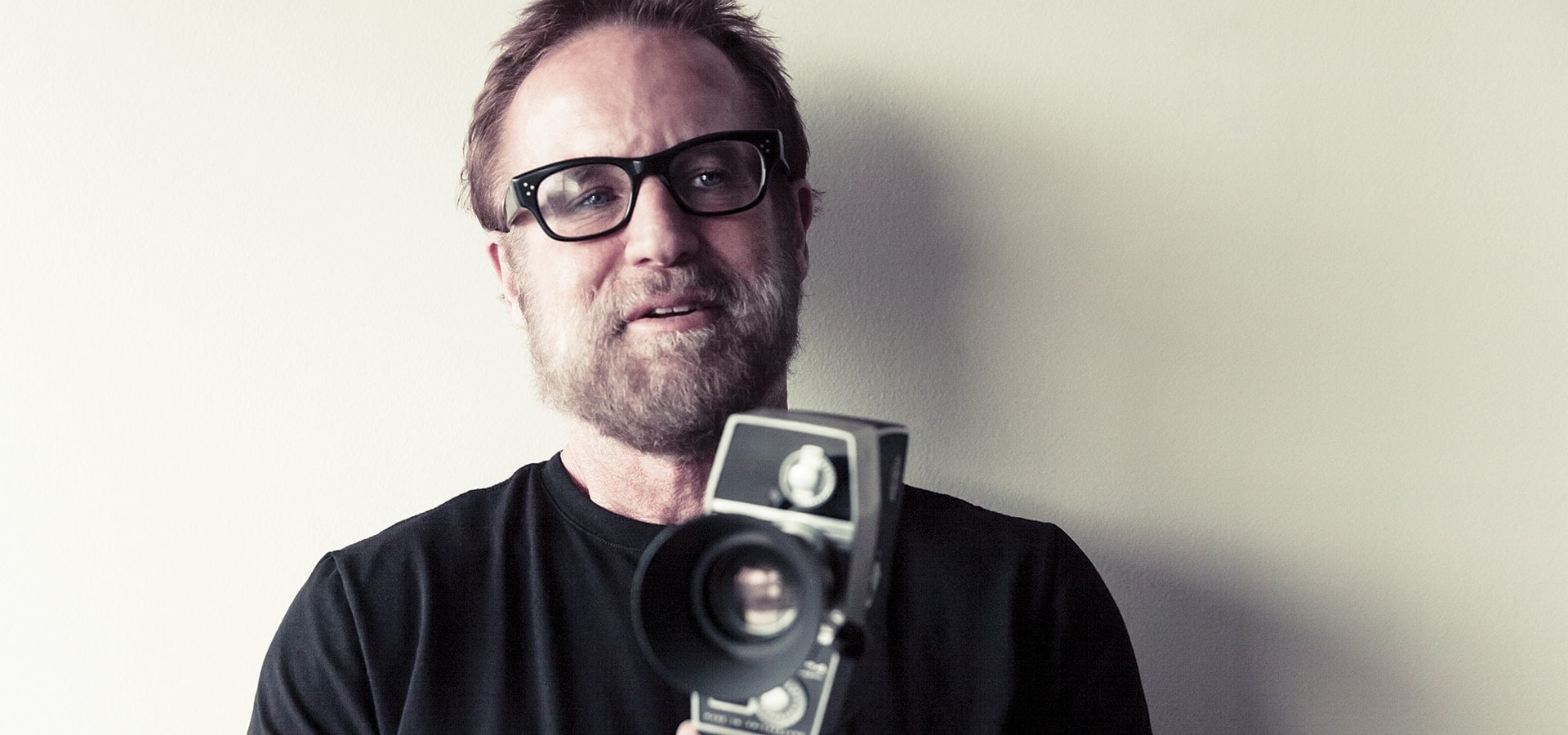
Visual Storytelling
The war years visuals are as stunning as the statistics. As 2 million people working in Southern California plants churn out 300,000 airplanes, we see blacks replacing Japanese Americans when the latter are sent to internment camps. We see more than 6,000 African Americans a month streaming into Los Angeles for work during the World War II years—and though their living conditions are shown as gruesomely crowded (apartments often occupied in shifts), one of the workers tells a camera, “The war made our lives better. It really did. Hitler got us out of the white folks’ kitchen.”
Later, as suburbs spring up after the war—“minimal traditional houses” lining long, straight, right-angled streets—African Americans are greeted with signs reading: “This tract is exclusive and restricted.”
Jones’ archivist, Brian Tessier, accumulated some 10,000 film clips for Blue Sky Metropolis, and they tell stories that are alternately eye-opening and delightful. We see Formica tables, electric kitchens, duck-and-cover drills, evolving hairstyles and fashions, Disney’s Tomorrowland and, naturally, cinematic sci-fi projections of the future. We see crazy contraptions plummeting to earth in the 1910 Los Angeles Air Meet. We see Voyager photos of Saturn and Jupiter, and deep-space images of galaxies almost incomprehensively far away.
The documentary is an extraordinary visual treat, and we’re left grateful that the photographic and cinematic arts evolved concurrently with the science of aviation.
To the Future
While 2020 could well be a year of award-reaping for Jones—Blue Sky has already been named a 2020 Golden Mike winner for best documentary by the Radio & Television News Association of Southern California—he is deep into his next project. It’s called All Man: The International Male Story. “It centers around the San Diego-based International Male catalog that came out in 1976,” he explains.
Catalog founder Gene Burkard thought that strong visuals and buff models could make men’s fashion more interesting to men “than what they were seeing in Sears or Brooks Brothers.” The catalog became phenomenally popular with gay and straight men alike.
“It’s a great way to tell a bigger story—the coming of age of the gay liberation movement and men’s fashion. Marky Mark. Gender fluidity and the spectrum of sexuality.” Teaser: Jerry Seinfeld’s poufy pirate shirt makes an appearance.
It’s fitting, of course, that such an ahead-of-its-time phenomenon hailed from Southern California—where, as the final episode of Blue Sky Metropolis tells us over a clip of SpaceX’s Falcon Heavy rocket lifting off from Vandenberg Air Force Base, “reality and fantasy thrive in equal measure.”
All four episodes of Blue Sky Metropolis will re-air on KCET in Southern California on March 22, 1 to 5 p.m., and the documentary streams on the KCET website at kcet.org/shows/blue-sky-metropolis. Many of Jones’ celebrity documentaries are available on streaming services. For information, visit peterjonesproductions.com






